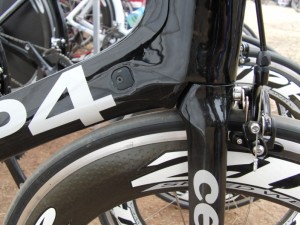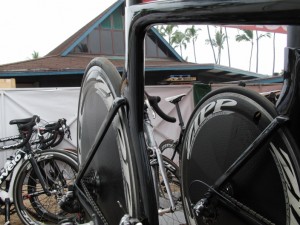The Cervelo P4 – Why it's Faster (Fastest?)
 I have written two other posts on the P4 – both from Kona. The initial post questioned whether it was worth the price upgrade from a P3- at first glance it looks like a P3 with a few tweaks. Then I talked with Cervelo’s Phil White and he set me straight. Last night I attended Cervelo night at our local shop BikeWorks, and watched their aerodynamics presentation and got some more info on what makes the P4 tick (better than the P3’s tick…).
I have written two other posts on the P4 – both from Kona. The initial post questioned whether it was worth the price upgrade from a P3- at first glance it looks like a P3 with a few tweaks. Then I talked with Cervelo’s Phil White and he set me straight. Last night I attended Cervelo night at our local shop BikeWorks, and watched their aerodynamics presentation and got some more info on what makes the P4 tick (better than the P3’s tick…).
Bottom line: 18 watts. That’s what this frame is worth at 30mph vs the P3. The drag savings come from four main areas: the chain stays, rear brake, front fork/frame interface, and the frame-integrated water bottle/stiffener/faring. The bike they had on display was still a prototype, and the waterbottle still didn’t fit right, but they have this fixed and the P4 will be hitting shops in March. It will come with 2 frame waterbottles, and the interchangeable tool kit and “stiffener” (i.e., faring).
The chain stays are a suprising source of drag reduction. But they are much broader in the horizontal plane than the stays on the P3. In fact some race wheels will not fit (as listed on their website). So apparently wedging the rear wheel tightly between the stays improves the flow over the rear wheel.
 The rear brake is almost completely hidden within the frame (covered by a removable faring – er… stiffener). Besides removing the brake from the wind, it also allows the seat cluster area to be much thinner and smoother than the P3’s. The question I heard alot was just how much gunk will accumulate in the brake compartment? 2nd, how hard will it be to service and adjust? The rear brake does have a quick release mechanism, as well as an inline barrel adjuster located near the cable port on top of the top tube behind the stem.
The rear brake is almost completely hidden within the frame (covered by a removable faring – er… stiffener). Besides removing the brake from the wind, it also allows the seat cluster area to be much thinner and smoother than the P3’s. The question I heard alot was just how much gunk will accumulate in the brake compartment? 2nd, how hard will it be to service and adjust? The rear brake does have a quick release mechanism, as well as an inline barrel adjuster located near the cable port on top of the top tube behind the stem.
The waterbottle seemed surprisingly easy to grab and drink from. It is supposedly refillable on the fly: you can flip open the nipple and you get a opening about 1.5″ in diameter. I wonder how well this will work in practice. Cervelo noticed that even with an aero bottle on the downtube, air flow stalled in the lower part of the main triangle, so they solved this by filling it with the bottle/stiffener. There are no mounting screws for a standard bottle. They say the most aero combo for long course is a conventional bottle between the arms on the aerobars, and then bottles behind the seat, mounted fairly high. This is something that seems to change annually – should rear-mounted bottles be low or high? Apparently the latest info says high.
The P4’s fork blends smoothly with the downtube and the front wheel is tucked closely against the downtube as well. I am still amazed that they couldn’t find a worthwhile (cost effective?) way to improve on front brake placement. The headtube is also narrower from the front and tapers more smoothly than on the P3. Other small improvements over the P3 include the internal cable routing and hidden binder bolts. All in all it makes for a very clean looking package vs the P3.
The Cervelo rep made an excellent point during the aero presentation: in the real world wind comes from the side. The wind vector is typically in the 5-15 degree yaw area, so a true aero bike should exhibit reduced drag in a yaw situation vs a head-on wind field. They presented a graph showing their carefully controlled wind tunnel test results using the fake Zabriske dummy rider (I would really like to see them automate dummy Zabriske so he can pedal). The results were from late 06 so some new bikes were not in the test, and they did not say which curve was which bike other than pointing out the Cervelos. But it was clear that a few bikes including the P3 and P2 improved in a yaw situation, while a whole bunch of other bikes had more drag in yaw (i.e., slowing you down on the queen K). It was also clear that the P2 and P3 were very close, but the P4 is in a whole new territory of low drag. Apparently some other frames that tested pretty well (Cervelo will not say anything about whose frames didn’t test well) were the Trek TTX and Specialized Transition, no surprise since they also spend alot of time in the tunnel. Note however that both of those frames fit very differently than Cervelos. Rumor has it that Trek will be introducing new TTX today, so we’ll see.
So that’s the P4 scoop. $6800 is a big nut in today’s economy, but amazingly other bike manufcturers are charging much more for their high-end bikes. Equipped with full SRAM red and a Fizik Arione Tri2 saddle, you won’t need to change anything on the P4. And much like the Model-T, you can get it in any color you like, as long as you like black.

January 23, 2009 @ 10:55 am
Todd, great overview of the presentation last night. Thanks for posting. So many of us have been infatuated with the arrival of the P4. Having seen it several times in person, I am still captivated by what appears to be a thoroughly tested bike. I think when people consider the purchase of a Cervelo bike (particularly the higher end models), consumer confidence rises exponentially because of the rigorous testing done. Other companies do it too, but nobody has marketed their wind tunnel experiences as well- and they have the results to back it up in the real world.
Relative to what other companies are charging for top end rides, the P4 is actually a pretty good deal. The P3C is a fantastic deal and the P2 is an astounding deal. For the fastest among us with the most on the line (kona slots, age group wins, etc…) the P4 strikes me as a serious bike that’s worth the money. Then again, there’s a fine line between want and need:) Great overview!